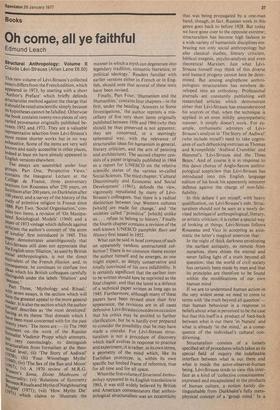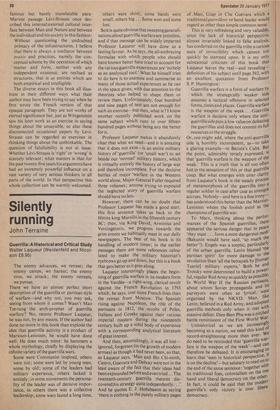Books
Oh come, all ye faithful
Edmund Leach
Structural Anthropology: Volume ll Claude Levi-Strauss (Allen Lane E6.50)
This new volume of Levi-Strauss's collected essays differs from the French edition, which aPPeared in 1973, by starting with a short 'Author's Preface' which briefly defends structuralist method against the charge that It should be rated unscientific simply because its hypotheses cannot be falsified. Otherwise the book contains twenty-two pieces of very varied provenance originally published between 1952 and 1973. They arc a valuable representative selection from Levi-Strauss's more recent shorter works but in no way exhaustive. Some of the items are very well !mown and easily accessible in other places, indeed at least six have already appeared in English versions elsewhere.
The essays are assembled under four groups. Part One, 'Perspective Views.' contains the Inaugural Lecture at the College de France, three anniversary orations (on Rousseau after 250 years, on Smithson after 200 years, on Durkheim after 1°0 Years), and a survey of the history of the study of primitive religion in France since 1888. Part Two. 'Social Organisation,' contains two items, a revision of 'On Manipuiated Sociological Models' (1960) and a Daper of 1973 vintage which defends against criticism the author's concept of 'the atom of kinship' first introduced in 1945. This taper demonstrates unambiguously that Strauss still does not appreciate that the English term 'filiation,' as used by British 30ctal anthropologists, is not the direct equivalent of the French filiation and, in e.,°osequence, he continues to confuse two diu.eas which his British colleagues carefully ,Istioguish under the labels 'filiation' and descent.
.Part Three, 'Mythology and Ritual,' With seven essays, is the section which will r?ave the greatest appeal to the more general he.ader. It is also the section which the author hirll.self describes as 'the most developed' ha, vlog as its theme 'that domain which I i'lve been most concerned with for the past cwentY years.' The items are:— (i) The 1960 c.°°111-1ent on the work of the Russian 'n°rrnalist Vladimir Propp which attempts, st°t very convincingly, to distinguish r ructuralism from formalism at the theo(eitleal level; (ii) 'The Story of Asdiwal' (19958); (iii) 'Four Winnebago Myths' (l962' (iv) 'The Sex of the Sun and Moon' Vui)1 (v) A 1970 review of M.R.G. b...asson's Soma, Divine Mushroom of Coriality; (vi) 'Relations of Symmetry i,7ween Rituals and Myths of Neighbouring (iu°,13les' (1971)• (vii) 'How Myths Die '11) which Claims to 'illustrate the
manner in which a myth can degenerate into legendary tradition, romantic literature, or political ideology.' Readers familiar with earlier versions either in French or in English, should note that several of these texts have been revised.
Finally, Part Four, 'Humanism and the Humanities,' contains four chapters—in the first, under the heading 'Answers to Some Investigations,' the author reprints a miscellany of live very short items originally published between 1956 and 1966 (why they should be thus preserved is not apparent; they are concerned, in a seemingly ephemeral way, with the relevance of structuralist ideas for humanism in general, literary criticism, and the arts of painting and architecture). The second chapter consists of a paper originally published in 1964 as a report for UNESCO on the relative scientific status of the various so-called Social Sciences. The third chapter, 'Cultural Discontinuity and Economic and Social Development' (1961), defends the view, vigorously repudiated by many of LeviStrauss's colleagues, that there is a radical distinction between 'our Western cultures [which] are made for change,' and 'the societies called "primitive" [which] unlike us . . . refuse to belong to history.' Finally the fourth chapter contains a revision or the well-known UNESCO pamphlet Race and History first issued in 1952.
What can be said in brief compass of such an apparently random unstructured collection? There is no common theme except the author himself and he emerges, as one might expect, as deeply conservative and totally convinced of his own infallibility. It is certainly significant that the earliest item to be written should here be reprinted as the final chapter, and that the latest is a defence of a technical paper written as long ago as 1945. Furthermore, although many of these papers have been revised since their first appearance, the revisions are in all cases defensive. Levi-Straussconcedes on occasion that his critics may be entitled to further clarification, but he is hardly ever prepared to consider the possibility that he may have made a mistake. For Levi-Strauss structuralism is not a procedure of discovery which itself evolves in response to practice and experiment ; it is rather, in its own terms, a geometry of the mind which, like its Euclidian prototype, is, within its own specific but limited frame of reference, true for all time and for all space.
Whenthe first volumeofStructuralAnthropology appeared in its English translation in 1963, it was still widely believed by British and American commentators that anthropological structuralism was an eccentricity
that was being propagated by a one-man band, though, in fact, Russian work in this genre goes back to before 1928. But today we have gone over to the opposite extreme; structuralism has become high fashion in a wide variety of humanistic disciplines embracing not only social anthropology 'but also classical studies, literary criticism, biblical exegesis, psycho-analysis and even theoretical Marxism. Just what LeviStrauss himself may think of this diverse and bastard progeny cannot here be determined. But among anglophone anthropologists structuralism has nowhere developed into an orthodoxy. Professional journals are constantly publishing well researched articles which demonstrate either that Levi-Strauss has misunderstood his sources or that, when the technique is applied in an even mildly unsympathetic manner, it simply doesn't work. For example. enthusiastic admirers of LeviStrauss's analysis in 'The Story of Asdiwal' (who include myself) need to take cognisance of such debunking exercises as Thomas and Kronenfelds"Asdiwal Crumbles' and Hammel's 'Levi-Strauss and the Three Bears.' And of course it is in response to this dawn chorus of Anglo-Saxon anthropological scepticism that Levi-Strauss has introduced into this English language edition of his book his apparently innocent defence against the charge of non-falsifiability.
In this debate I am myself, with heavy
qualification, on Levi-Strauss's side. Struc turalism should not be seen as a newly de vised techn ique of anthropological, literary, or artistic criticism; it is rather a special way of looking at things. Levi-Strauss follows Rousseau and Vico in accepting as axio matic the latter's magical assertion that : In the night of thick darkness enveloping the earliest antiquity, so remote from ourselves, there shines the eternal and never failing light of a truth beyond all question: that the world of civil society has certainly been made by men and that its principles are therefore to be found within the modifications of our own human mind.
If we are to understand human action in the very widest sense we need to come to terms with 'the truth beyond all quest ion'— that human behaviour is a response to beliefs about what is perceived to be the case but that this itself is a product of feed-back between what is out there 'in Nature' and what is already 'in the mind,' as a consequence of the individual's cultural conditioning.
Structuralism consists of a loosely specified set of procedures which takes as its special field of inquiry the indefinable interface between what is out there and what is inside the actor-observer-human being. Levi-Strauss tends to view this inter face as a kind of 'collective consciousness' expressed and encapsulated in the products of human culture, a notion barely distinguishable from Durkheim's fully metaphysical concept of a 'group mind.' In a famous but barely translatable para Marxist passage Levi-Strauss once des cribed this internal/external cultural inter face between Man and Nature and between
the individual and his society in this fashion : Without questioning the undoubted primacy of the infrastructures, I believe that there is always a mediator between praxis and practices, namely the conceptual scheme by the operation of which matter and form, neither with any independent existence, are realised as structures, that is as entities which are both empirical and intelligible.
The diverse essays in this book all illustrate in their different ways what their author may have been trying to say when he first wrote the French version of that opaque paragraph. They are not works of eternal significance but, just as Wittgenstein saw his later work as an exercise in saying things about the unsayable, so also these disconnected occasional papers by LeviStrauss can be regarded as exercises in thinking things about the unthinkable. The question of falsifiability is not at issue. Whether Levi-Strauss is 'right' or 'wrong' is scarcely relevant ; what matters is that for the past twenty-five years his arguments have had an extremely powerful influence on a vast variety of very serious thinkers in all parts of the world. In that perspective this whole collection can be warmly welcomed.











































 Previous page
Previous page